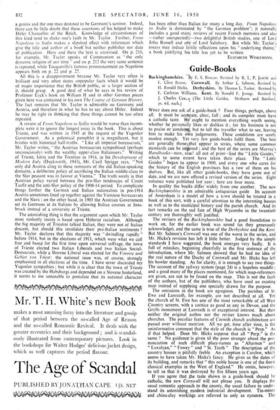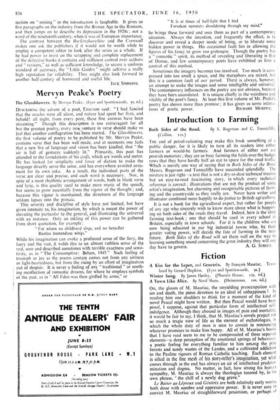Guide-Books
Buckinghamshire. .–"By E. S. Roscoe. Revised by R. L. P. Jowitt and E. Clive Rouse. ' Cornwall. By Arthur L. Salmon, Revised by H. Ronald Hicks. Derbyshire. By Thomas L. Tudor. Revised by E. Carleton Williams. Kent. By Ronald F. Jessup. Revised by J. Charles Cox.. 41 (The Little Guides. Methuen and Batsford. 7s. 6d. each.) WHAT does one ask of a guide-book ? Four things, perhaps, above all. It must be acelsrate, clear, full ; and its compiler must have a catholic taste. He ought to mention everything worth seeing, whether he personally likes or dislikes it ; for his business is not to praise or condenic but to tell the traveller what to see, leaving him to make his Coirn judgements. These conditions are surely modest enough. Yet very few guide-books fulfil them. The best are generally thoselthat appear in series, where some common standards can be iratosed ; and the best of the series are Murray's Handbooks—now, alas! all out of print—And the "Little Guides," which to some extent have taken their place. The " Little Guides " began to appear in 1900, and every one who cares for the history of the English provinces has a row of them on his shelves. But, like all other guide-books, they have gone out of date, and we are now offered a revised version of the series. Eight volumes were published last year; here are four more.
In quality the books differ widely from one another. The new Buckinghamshire is an admirable antiquarian guide. Its account of Amersham is a model of how a town should be treated in a book of this sort, with a careful attention to the interesting houses as well as to the municipal history and the parish church. And its tart remarks on the sad fate of High Wycombe in the twentieth century are thoroughly well justified.
The revisers of the Buckinghamshire had a good foundation to work on, for the earlier book was sound (as they generously acknowledge), and the same is true of the Derbyshire and the Kent. But Mr. Salmon's Cornwall was one of the worst in the series, and Mr. Hicks's revision has left it little better. Judged by the simple standards I have suggested, the book emerges very badly. It is full of mistakes, beginning cheerfully in the first sentence of the introduction, where Mr. Salmon showed that he had no idea of the real nature of the Duchy of Cornwall and Mr. Hicks has left his howler standing. As for clarity, it is enough to say two things. The account of the railway system (page 24) is a hopeless muddle ; and a good many of the places mentioned, for which map-references are given, are not to be found on the map. This is not the fault of the authors, but of the publishers, who have used an existing map instead of supplying one specially drawn for the purpose.
The omissions in the book are egregious. The parishes of St. Ewe and Lanreath, for example, are not described at all. Yet the church of St. Ewe has one of the most remarkable of all West Country screens, with a cornice as good as any in Devon, and the Grylls monument at Lanreath is of exceptional interest. But then neither the original author nor the reviser knows much about churches. The peculiar features of Cornish church architecture are passed over without mention. All we get, time after time, is the uninformative comment that the style of the church is " Perp." As if that helped. Does Mr. Hicks suppose that all " Perp." is the same ? No guidanceis given t6 the poor stranger about the pro- nunciation of such difficult place-names as " Altarnun " and " Luxulyan," " Fowey " and " St. Teath " The description of the country houses is pitifully feeble. An _exception is Carclew, which seems to have taken Mr. Hicks's fancy. He gives us the dates of its building, and remarks that " this noble house is one of the finest classical examples in the West of England." He omits, however, to tell us that it was destroyed by fire fifteen years ago.
If you agree that j.he taste shown in a guide-book should be catholic, the new Cornwall will not please you. It displays the usual romantic approach to the County, the usual failure to under- stand its astonishing modern industrial development. Tin-minesand china-clay workings are referred to only as eyesores. The
section on " mining " in the introduction is laughable. It gives us five paragraphs on the industry from the Bronze Age to the Romans, and then jumps on to describe its depression in the 1920s ; not a word of the nineteenth century, when it was of European importance. The contrast between the Buckinghamshire and the Cornwall makes one ask the publishers if it would not be worth while to employ a competent editor to look after the series as a whole. If he had power to insist on the scrapping and complete replacement of the defective books it contains and sufficient control over authors and " revisers," as well as sufficient knowledge, to secure a uniform standard of accuracy, the " Little Guides " might achieve a really high reputation for reliability. They might also look forward to another half-century of honoured and useful life.
JACK SIMMONS.





































 Previous page
Previous page